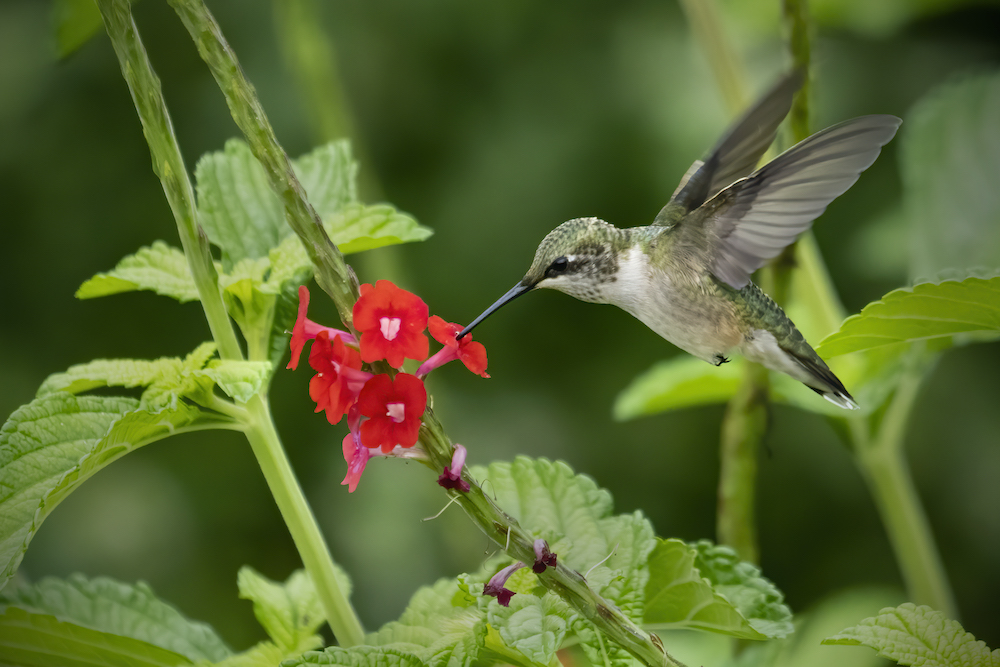As I was walking on the nature trail, I watched two hummingbirds duking it out. One hummingbird was chasing another for encroaching on “his” flowers. It was a very large clump of flowers, plenty for both. Yet his territorial instincts kicked in and he chased away his fellow diner, only to discover that he had lost his place to another hummingbird. Hummingbirds even act territorial at hummingbird feeders.
There are few people who don’t love hummingbirds. The males sport bright jackets of colors and even the doughty females amuse us with their feats of flight as they dart and hover over the flowers and feeders.
Hummingbirds are unique. Their metabolism is so fast that they must eat every 10 minutes and consume 50 percent of their body weight each day. On a typical day, hummingbirds burn between 6,600 to 12,000 calories. Hummingbirds have the highest metabolic rate of any vertebrate animal. During flight and hovering, oxygen consumption is about 10 times higher than that of elite human athletes. Hummingbirds take approximately 150 breaths per minute! To conserve energy when food is scarce and at night, they enter a torpor state similar to hibernation, where they slow their metabolic rate to 1⁄15 of its normal rate.
Hummingbirds eat many small meals. Because their high metabolism makes them vulnerable to starvation, hummingbirds are highly attuned to food sources. They digest their food rapidly and spend 20% of their time feeding. Our local ruby-throated hummingbirds prefer red or orange flowers (though it’s not necessary to color the sugar water in a hummingbird feeder).
Like many birds, hummingbirds have good color vision and can see the ultraviolet spectrum, which humans can’t see. Their eyesight acuity is better than ours as well.
Male ruby-throated hummingbirds don’t stick around after mating. This puts more stress on the female who must build the nest, incubate the eggs, and raise the chicks.
Ruby throated hummingbirds migrate to Mexico each year. They arrive in North America by late February and early March and return to Mexico and Central America in late November.
The lifespan of the ruby-throated hummingbird is short, from 3-5 years, with the highest death rates in yearlings. Scientists don’t know why, but their population has decreased by 17% in the 21st century.
What is most amazing about hummingbirds is their flight. Hummingbirds have compact bodies with relatively long, bladelike wings. Their anatomical features allow them to fly like a helicopter in any direction, including hovering. The ruby-throated hummingbird beats its wings about 53 times a second. Yes, that’s right, in a second!
All of these amazing facts bring me to the essential question, why are these beautiful creatures so territorial? If they cooperated and shared their bounty it would require less energy than they currently expend chasing off other birds. I believe that it is because hummingbirds, with their intense bodily requirements, dwell in a world of scarcity. If they do not feed every 10 minutes, they cannot sustain themselves. Lack of food, not cold, is why they migrate. Because their needs are so extreme, they see each morsel of food in desperate terms. In their scarce world, another hummingbird is a threat to their existence.
On the other hand, many Americans live in a world of abundance; America is a rich country with many resources. Despite that, some perceive the world from a scarcity perspective and act accordingly. If we see the world from a scarcity viewpoint, then we are more likely to exhibit bad behaviors. If we see the world from an abundance point of view, we don’t need to be territorial, there is plenty for everyone.
Unlike hummingbirds, we get to choose.
Angela Rieck, a Caroline County native, received her PhD in Mathematical Psychology from the University of Maryland and worked as a scientist at Bell Labs and other high-tech companies in New Jersey before retiring as a corporate executive. Angela and her dogs divide their time between St Michaels and Key West, Florida. Her daughter lives and works in New York City.


Write a Letter to the Editor on this Article
We encourage readers to offer their point of view on this article by submitting the following form. Editing is sometimes necessary and is done at the discretion of the editorial staff.